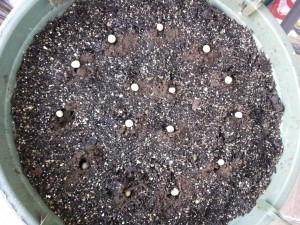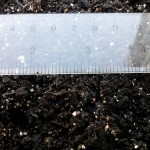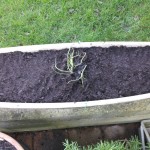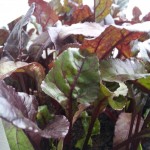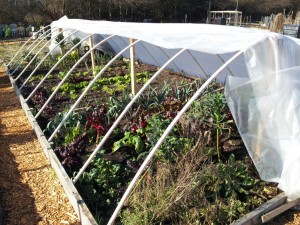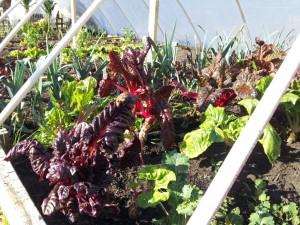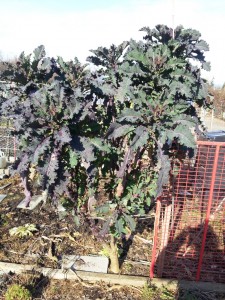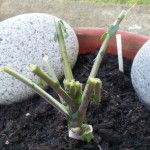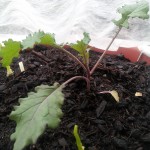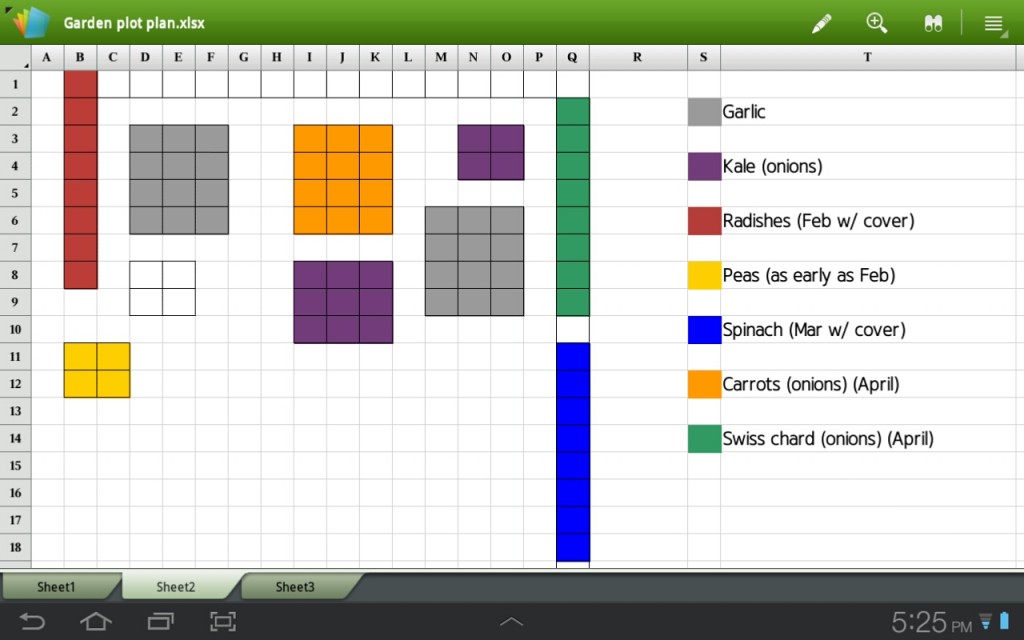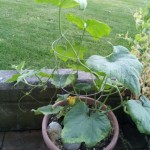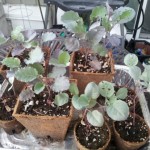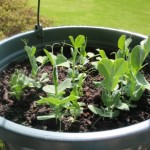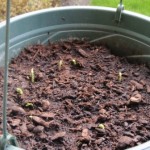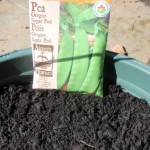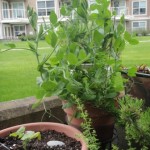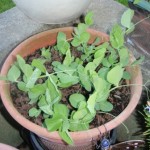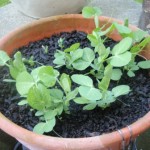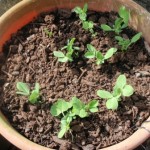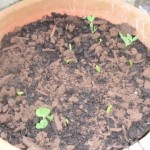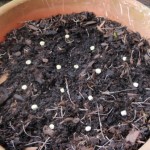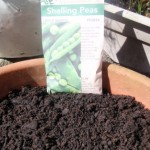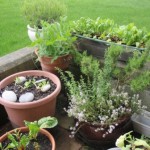First official sowing of 2013
Timing
Although I have been working in the garden for several weeks now and throwing seeds into the soil randomly to see what would grow, my first official seed sowing was this weekend on February 16, 2013. This is about 4.5 weeks earlier than last year, and the purpose is just to experiment with the micro-climate on my patio.
Soil
Over the winter I have been watching some interesting YouTube gardening videos and have picked up some tips especially for container gardening. This year I am focusing on building my soil and amending the existing Sea Soil in my containers with the following:
- Fresh Sea Soil compost (to add organic matter and maintain soil structure)
- Vermiculite (a natural lightweight mineral substance to maintain moisture)
- Worm castings (for nutrients and hopefully beneficial microbes)
- Rock dust (to add/replace trace minerals beyond the usual N-P-K in fertilizers)
- Dolomite lime (a few tablespoons, much of the soil has been in the containers for years and has never been limed, so is likely quite acidic)
- Dry ‘organic’ fertilizer (a few tablespoons, just because I have it and to replace some N-P-K)
- Crushed egg shells (run through the Magic Bullet, in theory it should add calcium to the soil, but I’m not sure it it is in a form that is available to the plants – the granular texture will also help with drainage)
Seeds
I sowed two containers of Oregon Sugar Pod, with both seeds that I had from last year and new seeds I purchased. As I did last year, I planted in a hanging basket and a 12″ pot, and used innoculant to promote the nitrogen fixing ability of these legumes. I decided not to use the Little Marvel seeds… at least not yet, as I had to re-sow a couple of times last year, so obviously they do not hold up to the cold, damp winter weather as well as Oregon Sugar Pod. I also moved the 12″ pot closer to the house so it is warmer and slightly covered — because perhaps the location of the container last year slowed germination.
I also sowed some spinach, as it is a cool weather crop which tends to bolt when the days get too long and hot warm. I have sowed a 12″ pot (that used to contain my poor old woody lavender) with Tyee, which is supposed to be a good year-round variety for us on the west coast. It apparently germinates in temperatures as low as 5°C, so I thought I’d give it a try in mid-February.
I also planted some Toy Choy, or baby bok choy. They grew quite well last year but we only got one real harvest from them as my second sowing bolted really quickly. So I thought starting a month sooner may help us get another harvest in. You may have to zoom in to see the seeds, but I sowed 3 rows in my long container. I also plopped in some scallion starts in the middle… which I’m unsure if they will make it this early in the year!
Aside from that, I am still slowly harvesting rainbow lacinato kale, gai lan, and beet tops every now and then, though next winter I will grow more so that I actually have more than a couple of leaves to eat at a time!
Visit to a community garden
On Friday we visited the local community garden where we hope to secure a plot this spring. We wanted to check out the plot sizes and general condition of the gardens, and found some inspiration too!
This hoop house covered the entire plot, which we eyeball at 8′ x 16′. They used PVC pipe ribs which were pushed down into the ground against the wood border, and supported by 2’x4’s in the middle and along the top.
They used plastic film, though in talking with a neighbouring gardener, it seems the plastic gets too warm and damp inside. I will likely use heavy row cover in the winter and then switch to light-weight row cover in the summer to maintain air circulation.
However, check out this amazing bounty (see pic below) these gardeners are growing in mid-Februrary.
Another garden plot is growing some kind of kale… perhaps Red Russian? I don’t think it’s a tree collard or tree kale, but I guess our winters are so mild that it’s turned into a tree. The ‘trunk’ was almost 2″ thick!
Random seed sowing
Well, my green thumb is itching to get planting, so I randomly planted one of my long containers today with Swiss Chard, beets, and spinach in hopes of starting a cool-weather-tolerant container of leafy greens that will be ready in the next couple of months. We’ll see how this goes!
UPDATE: I also just checked the Environment Canada long range probability forecasts and it looks like we are likely to have a 70%-80% chance of below normal temperatures this spring. Looks like it will be cool weather veggies for a while.
How to build a PVC hoop tunnel
This year I am near the top of the waiting list for a community garden plot, so I am already planning what to plant in it and how to extend the growing season.
A good way is to make a PVC hoop tunnel and cover it with plastic or fabric to protect plants from wind and pests. It’s essentially a poor person’s greenhouse and can create a microclimate inside by increasing the temperature depending on the type of covering used.
I found this video by FarmingFractals on YouTube that explains a simple and inexpensive way to construct a hoop house.
From this video, it seems all you need are:
- 4 x 1/2″ PVC pipe cut into 8′ lengths (for ribs)
- 2 x 1/2″ PVC pipe cut into 4′ lengths (for base)
- 6 x 1/2″ PVC pipe cut into 2.5′ lengths (or your preferred base length between ribs)
- 4 x PVC “side out” three-way corner joints
- 4 x PVC T-shaped three-way connectors (to secure ribs to the base of the frame)
- Your choice of row cover material
- 3/4″ PVC pipe to make clips*
- Saw for cutting PVC pipe
- Measuring tape
- Pencil
- Something to fix the frame to the ground (e.g. old tent pegs, bricks)
*Although FarmingFractals made his own clips out of larger PVC piping, it looked like the clips ended up chewing holes in the fabric. I may try to find some other way of securing the row cover material to the frame, especially on the side that I may open up more often.
Theft in the patio garden!
Although they got a late start, the Rainbow Lacinato kale was coming along nicely. I even got one handful of a harvest on January 2nd. It had been growing well under a lightweight row cover cloth, but seeing as how we were forecast to have a week+ of sunshine I thought I’d take the row cover off to allow as much sunlight as possible.
I also decided to pull out the fish fertilizer to try to bump up the nutrients as much as possible… and then it happened!
On Thursday morning I woke up to find that the kale plant closest to my patio edge was stripped down to the stalk.
On Friday morning I woke up to find that the thief had been back overnight, but at least this time had mercy and left a leaf and the growing tip.
The consensus on Facebook is that this is some type of rodent (rabbit, raccoon) coming by to eat the yummy leaves during this cold snap we are having. I have a feeling the fish fertilizer was the attractant.
Since the second plant may have a fighting chance, I have placed a toilet paper tube around the base and replaced the row cover. Hopefully this will be enough to keep the thief away. If not, I will use the GoPro and conduct some surveillance!
On another note the beets are still surviving, but I have my doubts that they are actually making any edible roots. It makes me wonder if these are the Kestrel variety I thought I got or if they are actually Bull’s Blood, which are grown for salad greens and don’t really make bulbs.
Fall/winter vegetables coming along
I may have mentioned that I am trying winter gardening this year.
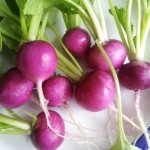 I have already harvested my radishes, which matured very quickly with our warm September. These were planted on September 10th and harvested the second weekend of October. We had an unseasonably warm and dry September this year, though I’m not complaining!
I have already harvested my radishes, which matured very quickly with our warm September. These were planted on September 10th and harvested the second weekend of October. We had an unseasonably warm and dry September this year, though I’m not complaining!
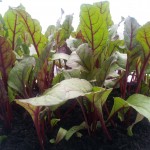 These Kestrel beets were also planted on September 10th and have been growing under a light weight row cover cloth to keep out pests. This progress picture was taken on November 2nd, and while I have added a layer of SeaSoil as mulch and moved the pot close to the building to keep them as warm as possible, it may still be a month before they are ready. These beets are growing in 18″ of soil.
These Kestrel beets were also planted on September 10th and have been growing under a light weight row cover cloth to keep out pests. This progress picture was taken on November 2nd, and while I have added a layer of SeaSoil as mulch and moved the pot close to the building to keep them as warm as possible, it may still be a month before they are ready. These beets are growing in 18″ of soil.
This is my first time growing kale. This is a Rainbow Lacinato kale, which is a cross between Redbor and Lacinato. This was also planted on September 10th and update photo taken on November 2nd, but I am a little disappointed in its growth. I know that through the fall growth will slow, but I will admit that since kale is a cold weather veggie I expected it to be huge by now! There is definitely new growth, and perhaps because this plant is growing where the Swiss chard lived in the summer time the soil may be a bit depleted. I can’t remember if I had added a bit of fertilizer prior to seeding, but regardless it may be too cold for the the fertilizer to break down and make the nutrients available. I just did a feeding of (stinky) liquid fish emulsion fertilizer. I have also topped it up with some new SeaSoil and dug in some glacial rock dust to amend the soil, so hopefully this all helps. My other Rainbow Lacinato which is growing in the pot that held the peas this summer seems to be doing a touch better. I’m guessing it is because the peas helped to fix nitrogen in the soil, especially since I used the inoculant.
This is also my first attempt at gai lan, an Asian vegetable that is like sprouting broccoli or rapini. I didn’t really know how big these plants get (this is why it wound up in the hanging basket) so I’m not sure how well it will do. I don’t expect to harvest anything until closer to February, but it seems to be doing well. Again, it could be due to the fact that it is in another planter which held peas and therefore there is good nitrogen content in the soil. Next year I may have to plant more of these if we actually want a meal of gai lan.
One vegetable that did not do well when I started it from seed in September was my new batch of Swiss chard. The plants I had throughout the summer had started to bolt, so I popped some seeds into one of my 6″ deep planters, but alas they are still a whole one centimeter tall.
You will also see that there are a few scallions popping up in some of the photos. I put out the roots from scallions we bought from the grocery store just to see if they would sprout again. Lo and behold even in the cold snap we had during October they sprouted up like it was nothing! I have started some more seeds indoors, and actually I even started some outdoors just to see what happens. The worst that can happen is, well, nothing! I’ll update in the future on how these little seeds do: Tyee spinach, Rouge d’Hiver lettuce, and Little Gem lettuce. The seeds I’ve got started indoors include Rouge d’Hiver, Little Gem, and Cimmaron lettuce, as well as Apache scallions.
Patiently waiting for spring
I have my meagre winter containers planted and still have no word as to whether we have been assigned a community garden plot, so in all my spare time I’ve planned out the patio garden for next year. It’s not the snazziest picture, but it makes sense to me!
The garlic and kale were planted this fall. The kale will be ready in the new year and the garlic next July. The radishes, spinach, and chard will be grown in the long planters that sit on the concrete surround. The pot with the carrots currently holds beets (which I am hoping to harvest near Christmas time. I will have to transfer the soil into some of the long pots, as according to rotation gardening I shouldn’t plant root veggies in the same place consecutively. The hanging basket which will hold peas again in 2013 currently holds my gai lan plant, which I’m beginning to doubt if the container is large enough, but we’ll see! I’m also planning on interspersing scallions amongst some of the planters in order to deter pests. We’ll also see how that works.
It’s been a while!
It’s been a while since I wrote a post. Summer time got very busy and while the garden kept growing, I didn’t get to update as much as I had hoped. Here’s a run down of how things went:
 The sugar peas grew really well in the hanging basket and gave us several harvests – it seemed to just keep growing more and more pea pods! However, we have to make sure we’re at home when they’re ready to be picked!
The sugar peas grew really well in the hanging basket and gave us several harvests – it seemed to just keep growing more and more pea pods! However, we have to make sure we’re at home when they’re ready to be picked!
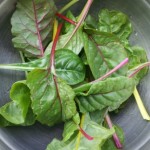 The Swiss chard grew well as cut-and-come-again baby salad greens, but I had a mid-summer infestation of leaf miners. These little pests bore tunnels between the top and bottom layers of the leaf, and cause a fair bit of damage! I had to keep cutting and throwing out the leaves with the leaf miners to get rid of them to prevent them from turning into moths which would then lay more eggs in the soil. I broke the cycle by the end of August, but by then some of the plants had bolted. Next year I’ll plant fewer plants and let them grow larger. I’ll also use a row cover to keep the moths away!
The Swiss chard grew well as cut-and-come-again baby salad greens, but I had a mid-summer infestation of leaf miners. These little pests bore tunnels between the top and bottom layers of the leaf, and cause a fair bit of damage! I had to keep cutting and throwing out the leaves with the leaf miners to get rid of them to prevent them from turning into moths which would then lay more eggs in the soil. I broke the cycle by the end of August, but by then some of the plants had bolted. Next year I’ll plant fewer plants and let them grow larger. I’ll also use a row cover to keep the moths away!
I only ended up with one (small) butternut squash – barely 6 inches in length. The photo above is a picture of a female fruit-bearing blossom. I had to hand-pollinate the blossoms with the male blossoms because I only had one plant and the flowers opened one at a time. Next year, I don’t think I will grow squash again.
I had also planted some kale and gai lan seedlings in mid-July for winter gardening, and set them out in August to get acclimated to the outdoors. However, they got decimated by cabbage moth larvae – big fat green caterpillars!
So I wound up direct seeding my pots on September 10th with kale, radishes, gai lan, Swiss chard, and beets. We had an amazingly warm and dry September, so luckily most of the seedlings had a great start! More on that next time!
Also, I’m hoping to get into a community garden plot next year, so I’ll be able to have a proper garden! I’ll still grow in the containers on my patio, but having a garden plot will allow me to grow a bigger range of veggies!
Sugar and Shelling Peas
This year I planted two varieties of peas: Little Marvel, a bush variety; and Oregon Sugar Pod, a trailing variety. I have never tried growing peas in containers before, so here is my progress thus far.
 This is a trailing variety that grows to about 3 feet. I decided to try this in a hanging basket to make use of the vertical space on my small patio. It has started to blossom, so hopefully I’ll be picking and eating sugar peas soon! Some of the leaves are yellowing & I’m not sure if it requires a feeding or if it was getting too much rain last week. I’ll try a feeding when I water them tomorrow and see what happens. It has been slower than the suggested 75 days to harvest.
This is a trailing variety that grows to about 3 feet. I decided to try this in a hanging basket to make use of the vertical space on my small patio. It has started to blossom, so hopefully I’ll be picking and eating sugar peas soon! Some of the leaves are yellowing & I’m not sure if it requires a feeding or if it was getting too much rain last week. I’ll try a feeding when I water them tomorrow and see what happens. It has been slower than the suggested 75 days to harvest.
 This is a bush variety of shelling pea that is meant to grow in a nice, compact manner in a container. I’ve provided a tomato cage for additional support as some of the branches are floppy. After a slower start and having to re-seed sections of the pot several times, these peas seem to be doing well in the container. It has also been slower than the suggested 76 days to harvest, but that is likely due to the need to re-seed.
This is a bush variety of shelling pea that is meant to grow in a nice, compact manner in a container. I’ve provided a tomato cage for additional support as some of the branches are floppy. After a slower start and having to re-seed sections of the pot several times, these peas seem to be doing well in the container. It has also been slower than the suggested 76 days to harvest, but that is likely due to the need to re-seed.
Fresh herbs
Fresh herbs are some of the easiest edible plants to grow in containers. Many (but not all) herbs are perennial plants, meaning they will continue to grow year after year. Here are the perennial herbs I have in my container garden:
Chives
Chives grow readily from seed or you can purchase a pot of them pre-sprouted from the nursery. Since purchasing ours in 2006, we have not had to replant them. They just keep thriving, year after year, regardless of how much I neglect them. On my patio, they begin sprouting quite early, usually in February or March. There is usually enough to pick by April. When they flower, I often pick the flowers to put in a vase and let a few dry on the plant then shake the seeds out on the soil to keep building up my clump of chives. I find that they tend to die down in the heat of summer, but then perk up again in Fall.
Lavender
I have a pretty little fragrant Munstead lavender, which is a dwarf variety that I have had for several years now. I actually don’t do anything with it other than enjoy the blooms and watching the bees that come with it. I suppose you can bake with lavender or pick and dry the flowers just before they bloom. It is very low maintenance, and has done very well in its container through the winter. I generally just trim the flower stems some time through the winter, and provide some new compost at the top of the pot in Spring.
Mint
Mint is essentially an invasive weed, so be very careful where you decide to plant it. It develops an extensive and hardy root system that takes a long time to dig out. This is a plant that you definitely want to keep in a container, whether or not you have a large garden. On the plus side, it is easy to care for and thrives under almost any conditions. It’s nice to have a mojito with fresh mint from your garden in the summer, or make a yummy watermelon, mint and red onion salad.
Oregano
Oregano is a lovely plant with soft fragrant leaves. It spreads nicely and shares a container with Rosemary and Thyme. Unfortunately, this container has had a spittle bug infestation over the last couple of years, and my oregano has been a particularly favourite home for them. Spittle bugs secrete a bubbly mass from their bums, so I tend not to eat this oregano. However, it flowers and attracts bees to my garden, so I’ll keep it around for now.
Rosemary
Rosemary has been quite simple and low maintenance. It is an evergreen and handles our winters well. We use some fresh sprigs for roasted chicken or lamb. This is a handy herb to have around, even though dried rosemary is pretty good too. It has remained a low growing, woody plant in the container. I’m not sure if it is supposed to be more bushy, but it seems to be healthy enough.
Thyme
Thyme is also an easy plant to grow as it just comes back year after year. It flows over the edge of the container nicely, and the sprigs dry easily. We have gone many years now not needing to purchase dried thyme because all we need comes from the garden. It too flowers nicely attracting bees to our little garden.
What hasn’t worked too well
I have tried to grow Basil, but I don’t have enough sunlight for it to thrive. It needs a lot of sun and warm temperatures. Cilantro (or Coriander) is also an easy one to have in the garden, but mine have always bolted, or gone to flower and then to seed, much too quickly. Neither of these are perennials, but they may grow well for those with sunny, bright and warm balconies and patios with no sunlight restrictions. Because my patio faces the inner courtyard, the east and west wings of our building cut off the sunshine in the morning and evening. This also cools off our patio in the evening whereas plants like Basil like their roots to be warm as much as possible.
